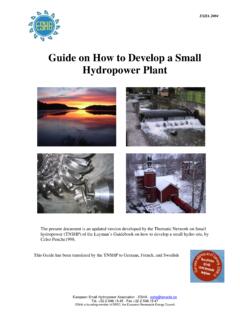Transcription of Guide on How to Develop a Small Hydropower Plant
1 ESHA 2004 Guide on How to Develop a Small Hydropower Plant The present document is an updated version developed by the Thematic Network on Small Hydropower (TNSHP) of the Layman s Guidebook on how to Develop a Small hydro site, by Celso Penche1998. This Guide has been translated by the TNSHP to German, French, and Swedish European Small Hydropower Association - ESHA - Tel. + - Fax + ESHA is founding member of EREC, the European Renewable Energy Council ESHA 2004 INDEX Acknowledgements i Executive Summary ii Chapter 1.
2 Introduction 1 Chapter 2. Fundamental of Hydraulic Engineering 12 Chapter 3. Evaluating Stream Flow 42 Chapter 4. Site Evaluation Methodologies 71 Chapter 5.
3 Hydraulic Structures 91 Chapter 6. Electromechanical Equipment 152 Chapter 7. Environmental impact and its mitigation 199 Chapter 8. Economic analysis 236 Chapter 9.
4 Administrative procedures 254 Glossary 290 European Small Hydropower Association - ESHA - Tel. + - Fax + ESHA is founding member of EREC, the European Renewable Energy Council Guide on How to Develop a Small Hydropower Plant ESHA 2004 ACKNOWLEDGEMENTS This Guide is an updated and adapted version of the publication Layman s Guidebook on How to Develop a Small hydro Site , published by ESHA - the European Small Hydropower Association in 1998 in the frame of the European Commission DG-TREN (Directorate General for Transport and Energy) ALTENER programme.
5 Although based on the original, this Guide has been entirely updated and adapted due to significant changes in the sector in the latest years as concern environmental and administrative aspects in particular. The updated version is available in English, French, German and Swedish what has added value to the already existing Spanish and Italian versions of the original publication. The Guide on how to Develop a Small hydro Site has been carried out within the EC Project Thematic Network on Small Hydropower , financed by the Fifth RD&D Framework Programme (FP5).
6 It has been updated and adapted by a Revision Committee under the coordination and guidelines of ESHA. Members of the Revision Committee include the project partners Francis Armand (ADEME), Anton Schleiss (EPFL-LCH), Erik Bollaert (EPFL-LCH), Pedro Manso (EPFL-LCH), Jochen Bard (ISET), Jamie O Nians (IT Power), Vincent Denis (MHyLab), Bernhard Pelikan ( VFK), Jean-Pierre Corbet (SCPTH), Christer S derberg (SERO), Jonas Rundqvist (SERO) and Luigi Papetti (Studio Frosio). The network thanks Steve Cryer (BHA) for his input.
7 Special thanks to Celso Penche (ESHA), author of the Layman s Guide , who has revised the contents of the current Guide guaranteeing its consistency and accuracy. ESHA 2004 iGuide on How to Develop a Small Hydropower Plant ESHA 2004 EXECUTIVE SUMMARY Developing a Small Hydropower site is not a simple task. There are many aspects which have to be taken into consideration, covering many disciplines ranging from business, engineering, financial, legal and administration.
8 These will all be necessary at the different development stages from, first choosing a site until the Plant goes into operation. The Laymans Guide Guide brings together all of these aspects in a step-by-step approach, and will serve as a useful tool for a potential developer of a Small Hydropower scheme. This Guide is divided into nine chapters and covers the basic concepts, meaning of definitions and technological issues to be addressed. Chapter 1 Introduces basic concepts, such as the definition of Small Hydropower , types of schemes , ways of exploiting the water resource available and gives a general overview of the Guide s contents, Chapters 2 through to 9 describe the essential steps to be followed to evaluate a proposed scheme before deciding whether to proceed to a detailed feasibility study.
9 The basic concepts considered in the Guide are: Topography and geomorphology of the site. Evaluation of the water resource and its generating potential. Site selection and basic layout. Hydraulic turbines and generators and their control. Environmental impact assessment and mitigation measures. Economic evaluation of the project and financing potential. Institutional framework and administrative procedures to obtain the necessary consents Reading this Guide will inform the potential Small Hydropower developer and give a better understanding of the different issues, phases and procedures that need be followed to Develop and run a Small Hydropower operation.
10 Bernhard Pelikan President ESHA iiGuide on How to Develop a Small Hydropower Plant ESHA 2004 CHAPTER 1: INTRODUCTION CONTENTS 1 2 A free fuel resource potentially 2 Definition of Small 3 Site 3 Run-of-river 3 schemes with the powerhouse at the base of a 5 schemes integrated within an irrigation 7 schemes integrated in a water abstraction 8 Planning a Small Hydropower 8 LIST OF FIGURES Figure 1-1 High head 4 Figure 1-2 Low head scheme with 4 Figure 1-3 Low head scheme integrated in the 5 Figure 1-4 Low head scheme using an existing 6 Figure 1-5 Low head scheme siphon 6 Figure 1-6 Integrated



